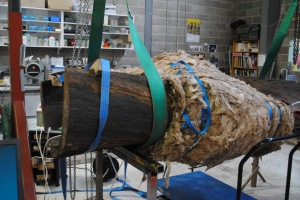Susie Dalton, former Archaeology student in the School of History, Classics and Archaeology at the University of Edinburgh, wrote her MA dissertation on Treasure Trove in Scotland and the reporting of artefacts by metal detectorists. Here she writes on the role of the NFA in supporting museums to make acquisitions through the Treasure Trove process.
The National Fund for Acquisitions helps Scottish museums and galleries to acquire a wide range of items of cultural and historical significance. While archaeological artefacts take up a small proportion of the annual grant, they do account for a significant proportion of applications received; in 2013/14 35% of applications were for archaeological material although this accounted for only 9% of total spend. Many of the archaeological finds made in Scotland today by members of the public are made by metal detectorists due to a growth in popularity of the hobby since the 1980s.
Under Scottish law ownerless objects found by chance, or through activities such as metal detecting, field walking or archaeological excavation, become the property of the Crown and may be claimed as Treasure Trove. While individuals have a legal responsibility to report their finds, the Treasure Trove Unit (TTU) works hard to promote awareness of the Treasure Trove system and advise which categories of object finders are required to report. This has resulted in a 100% increase in reporting since 2011. Many of the items found and reported as Treasure Trove have the potential to make a significant contribution to our understanding of Scotland’s past and the TTU works to ensure they can be enjoyed by the public and for research. If an item found by a member of the public is claimed, it is advertised to the museums sector. Individual museums may apply for the object to be allocated to their collection if it falls within the remit of their collecting policy. The recipient museum is asked to fund an ex gratia payment to the finder, usually based on the market value of the object. The NFA can offer a grant of up to 50% of the award. This means that the NFA offers crucial help to small museums local to the findspot of the artefact; museums that could otherwise miss out on exciting acquisitions owing to insufficient funding to meet the ex gratia award. As Dunbeath Heritage Centre manager Meg Sinclair put it:
In the past anything valuable that was found usually ended up going to Edinburgh […]These coins being displayed at the museum is a real coup for us.
Meg was referring to a hoard of medieval coins found by a metal detectorist in the Highlands in 2013. The coins, which date back to the 13th century, are now on display in the Centre thanks to NFA funding half the £2,210 ex gratia award and they are expected to contribute to increased visitor numbers.
A similar story can be found at the opposite end of the country in Dumfries and Galloway where the NFA helped Stranraer Museum to acquire a remarkable find in 2013 – an early Bronze Age gold lunula (a kind of flat, disc-like necklace), the first found in Scotland in over a century. Contributing a grant of £1,500, the NFA made it possible for a small museum to add this impressive piece to its collections.
The NFA provides a lifeline to small museums which want to display the archaeological finds made in their area. While the majority of finds don’t require a significant proportion of the NFA’s budget, they do make a considerable difference to small museums and their local communities, especially when many are facing increasing budget cuts. By helping museums across the country to acquire and celebrate these finds, the NFA is allowing Scotland’s heritage to be enjoyed by all. As the number of archaeological finds made and reported in Scotland continues to increase as a result of the TTU’s outreach work, the NFA has an important part to play in ensuring they continue to be seen and enjoyed by as many people as possible.
Susie Dalton










